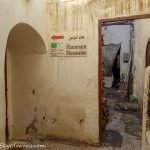Most people head to Chiang Rai to see the White Temple or perhaps the Blue Temple, but I think the Black House Museum is the best attraction there.
What is The Black House Museum
In Thai, baan means house and dam means black (you put the adjective after the noun in Thailand). The name Baandam is literally that – someone’s black house. But that’s like just calling Disneyland a park. I’ve been to some really unique and unusual museums around the world, and the Black House in Thailand is in the top of that list.
Baandam was the abode of Thawan Duchanee, a Thai painter and sculptor born in Chiang Rai in 1939. Around 1975, he started work on the Black House. Over the next 40 years, it was expanded into more than 15 buildings on 40 acres of land. Many of the buildings have temple shapes (Mr. Duchanee was also an architect), while other buildings are shaped like…well, you’re going to have to figure that out for yourself.
Thawan Duchanee constructed the buildings to house his extensive collection of personally created works of art, as well as other pieces of artwork he collected from his travels around the world. Aside from art (or perhaps you could call them art too), there are animal hides and horns (he had a proclivity toward alligator and crocodile skins) adorning the floors, tables and walls, rocking horses in the yard, throne seats, statues of every description, and a few other artifacts of a more macabre nature.
Since the construction of the Black House, the family has let visitors come to view everything it contained. This gave it the moniker of a museum. For years the museum was free, but in 2016 the Black House started charging visitors a paltry sum of 80 baht ($2.30) to help with the maintenance costs of the house.
A Visual Tour of the Black House Museum
A tour of the Black House Museum starts at the massive, temple-shaped main building. There’s a small temple out front with a shrine inside. The landscaping is pebbles and concrete, suitable for Thailand’s hot climate.
Entering the main house is like stepping into a man-cave the size of a warehouse. To the right, you have hanging columns of wood carved with hieroglyphs. In the center of the house is a golden tapestry reaching up to the rafters. Large tables surrounded by benches are the main articles of furniture in the room. Statues, horns, peacock feathers and crocodile/alligator skins decorate the otherwise sparse room. Even when it’s crowded, there’s enough space to get the photos you want without having them full of other tourists.
Surprisingly, there aren’t any signs [yet] telling you not to touch the artifacts in the museum…at least not that I saw. You can run your hands over the texture of the animal skins, hug the columns (if that’s your thing) or sit in the Game of Thrones-esque seats surrounding the long tables for a fantastic selfie. The one thing I really couldn’t figure out was why people were putting currency bills in the mouth of the giant snakeskin sitting on one of the tables.
Behind the main building and throughout the grounds are two dozen or so smaller buildings, most of which have a similar temple design.
The first one is full of horns, benches, cowhides and…bowls? They look like bowls, but I’m sure they had some specific purpose, and probably a different name too. The one disadvantage of the Black House Museum is that there are no guides. Granted, most everything is just a visual feast, but it would be nice to also get some of the nifty facts behind the artifacts.
Now it starts to get really weird. On your left, there’s a little outhouse with working toilets, split in half for male and female. On the male side, clearly identified with a fifteen-inch phallic symbol, is a small room full of maracas. At least that’s what my silly mind seemed to tell me I saw in the first split second. Then their shapes fully registered and I realized I was looking at a room full of carved dicks coming out of some rather large, single cojones…most of which were about the size of softballs.
The woman’s side is just as creative. There’s another sign with a large, open vagina, similarly proportioned to the earlier penis. However, inside is probably the last thing you ever wanted to see in a woman’s bathroom. This is apparently where Mr. Duchanee chose to keep his insect collection! The walls are covered with glass cases full of insects, and not small ones either. Beetles are predominant, but there are some tarantulas, locusts and scorpions too.
At the end of the property on the left is another building, and this one really takes the piss (to use the British expression meaning “to make a joke”). It’s shaped like another temple, but it’s full of toilets and the sign out front has two more large carvings depicting the two genders.
The next several houses contain what could be considered living rooms and bedrooms, except that you’d almost never see these as separate buildings, and they’re more about displaying unique and bizarre artifacts than they are for living or sleeping. Some of the houses are also raised up on piles several feet above the ground. They’re boarded up and the museum pieces are on display beneath the house.
As you turn right and make your way to back to the entrance, you’ll find some of the larger buildings (although not as big as the first). They hold hundreds more artifacts – mostly big ones that wouldn’t fit into the smaller buildings. There are huge drums, skeletal systems of various large animals, rocking horses and dozens of baskets (both for carrying and for fishing).
Spread throughout are more macabre artifacts and carvings. At the entrance of a large, wall-less building is a mobile full of hanging one-eyed monsters…if you know what I mean. There are some feminine counterparts, but apparently those didn’t impress the owner as much.
If you thought it couldn’t get any stranger, you were wrong. The next building is the actual house of the late Thawan Duchanee, but it’s not a house like you’ve ever seen before. It’s in the shape of a fish, or perhaps a whale, or a prehistoric creature… Whatever it is, it definitely stems directly out of the mind of Mr. Duchanee. I’ll just let you come to your own decision from the photos below what you think it is.
Finally, there are three white, round houses like permanent yurts. Approach the first one slowly as you might be taken aback by the character standing in the doorway. Well, maybe not the full character, but at least the foot and a half shaft sticking out at you. Behind him, the room is full of conch shells. You know, the ones with a pink slit in them?
There are few more buildings on your way back to the entrance. Trying to catalog and describe everything would be a Herculean job. Suffice to say, there is a lot to see.
Visiting the Black House Museum
The Black House Museum is located about 10 miles north of the center of Chiang Rai. Chiang Rai is a large city about 200 miles north of Chiang Mai. It takes about 4 hours on a bus to get from Chiang Mai to Chiang Rai. From Chiang Rai, find the bus headed to Mae Sai (the city on the border of Myanmar). The bus to Mae Sai is 39 baht, but they’ll only charge you 20 ($0.60) if you tell them you’re going to the Black House Museum. They’ll also tell you when it’s time to get off the bus for the museum.
The museum is open from 9 a.m. to 5 p.m. every day. As mentioned, tickets are 80 baht. Children under 18 and anyone with a disability get in free. How long will it take to explore the museum? That’s completely variable. Personally, I move really fast (although I also take a ton of photos) and I was able to see everything I wanted to in the museum in about two hours. If you didn’t want to take photos in every one of the buildings, you could probably get through the museum in the same amount of time, but I’d probably recommend three or four hours if you really want to see everything.
If you’re on a tour, there’s a good chance you won’t get a full three or four hours on the tour, or even two hours. Thus, if you are on a tour, you’ll have to plan out your route a little. Get ready to move quickly and try to stay ahead of the crowd. My recommendation is to visit the Black House Museum on your own using the bus system mentioned above, or renting a scooter.
Click to Pin It!
Further Reading
If you’re looking for more attractions in Chiang Rai or perhaps want to visit Pai (a village near Chiang Rai up in the mountains), here are some more stories..
- 10 Activities to Do In and Around Chiang Rai, Thailand
- 5 Ways to Skip the Massive Crowds at the White Temple in Chiang Rai
- A Day Exploring the Sai Ngam Hot Springs and Pai Canyon – Pai Part 1
- Christmas in the Hippie Village of Pai and a Secret Waterfall, Pai Part 2
Finally here’s some extra reading to save hundreds on your next vacation or stage of your journey.
- 5 Steps to Book Cheap Flights
- Hostels: To Book or Not to Book
- Is Workaway Worth it for the Traveler?
This post may contain affiliate links. These links help give me the wherewithal to continue traveling at no additional cost to you. For more information, click here.



































2 Comments
Great photos. That is an Excellent museum indeed. It’s so interesting. Enjoying some photos more than others:)
Ooh, you would have absolutely loved the museum. And I took so many more photos, but I could only put so many into the article.